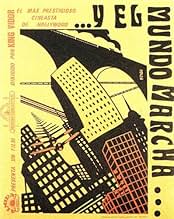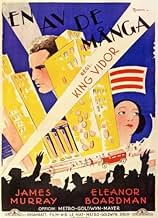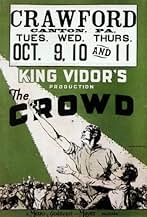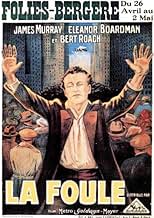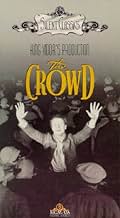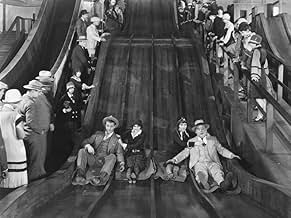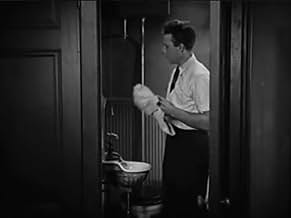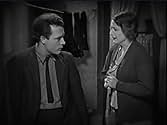CALIFICACIÓN DE IMDb
8.0/10
9.8 k
TU CALIFICACIÓN
John, siendo un joven huérfano desde temprana edad, se adentra en la vida en el Nueva York de principios del siglo XX. En compañía de su esposa, afronta los desafíos que implica perseguir el... Leer todoJohn, siendo un joven huérfano desde temprana edad, se adentra en la vida en el Nueva York de principios del siglo XX. En compañía de su esposa, afronta los desafíos que implica perseguir el sueño americano.John, siendo un joven huérfano desde temprana edad, se adentra en la vida en el Nueva York de principios del siglo XX. En compañía de su esposa, afronta los desafíos que implica perseguir el sueño americano.
- Dirección
- Guionistas
- Elenco
- Nominado a 2 premios Óscar
- 4 premios ganados y 2 nominaciones en total
John D. Bloss
- Boy on Fence
- (sin créditos)
Roy Bloss
- Boy on Fence
- (sin créditos)
Sidney Bracey
- John's Supervisor
- (sin créditos)
Johnny Downs
- John - Age 12
- (sin créditos)
Sally Eilers
- Party Girl at Bert's Place
- (sin créditos)
Joseph W. Girard
- Member of Board of Directors
- (sin créditos)
Pat Harmon
- Truck Driver
- (sin créditos)
Chris-Pin Martin
- Worker in Hallway
- (sin créditos)
Claude Payton
- Undetermined Secondary Role
- (sin créditos)
Opiniones destacadas
This is easily on the best silent films that I have seen. I got caught up in the story right from the beginning. To a degree, this is a story of the great mass of people that make up "The Crowd." As is pointed out in the beginning, a story of a man who is indispensible to New York (as most think.) He isn't. He thinks he is better than those he works with and is constantly waiting for 'his ship' to come in (which doesn't). In the end he almost loses his wife because of that.
I really enjoyed the scene early in the movie when he and a friend are going to Coney Island with two girls and both stop to watch the girls go up stairs so they can look at their legs. Probably somewhat risque' in 1928.
The film really stands out for the editing. Especially when you remember that this was made in 1928. It is used to also give you excellent views of New York and life in 1928.
I will see this one again and again.
I really enjoyed the scene early in the movie when he and a friend are going to Coney Island with two girls and both stop to watch the girls go up stairs so they can look at their legs. Probably somewhat risque' in 1928.
The film really stands out for the editing. Especially when you remember that this was made in 1928. It is used to also give you excellent views of New York and life in 1928.
I will see this one again and again.
I recently watched this silent movie and I was amazed by its timelessness.
People work everyday on an eight-hour job and has dreams to make it "BIG". In that way, he could stand out of "The Crowd". Eighty years later and people still go through the same routine. Any working person can symphatize with John Sims.
In my humble opinion, the movie is a precursor of the neo-realist movies produced in Europe during the post-World War II era. The movie, in a way, also prophesied the worse: The Great Depression. John Sims, who symbolizes the common man, found it difficult landing a stable job after he quit his previous one.
A great movie, I hope this one must be watched by the viewers of today.
People work everyday on an eight-hour job and has dreams to make it "BIG". In that way, he could stand out of "The Crowd". Eighty years later and people still go through the same routine. Any working person can symphatize with John Sims.
In my humble opinion, the movie is a precursor of the neo-realist movies produced in Europe during the post-World War II era. The movie, in a way, also prophesied the worse: The Great Depression. John Sims, who symbolizes the common man, found it difficult landing a stable job after he quit his previous one.
A great movie, I hope this one must be watched by the viewers of today.
Skilled technique and a thoughtful approach to the lives of some ordinary characters make "The Crowd" a memorable drama that tells an interesting, if mostly downbeat, story with some worthwhile observations on human relationships. It takes skill and judgment to make a memorable movie out of this type of material, and "The Crowd" is one of numerous quality pictures from the final years of the silent era that deserve to be much better remembered.
James Murray and Eleanor Boardman are completely believable as a typical couple starting out with all kinds of dreams and expectations. As they gain increasing experience in the real world, their reactions to events, especially on Murray's part, are by no means always appealing, but they are always genuine. The characters' flaws are made clear, yet you cannot help wishing for better things for them.
The story is structured carefully, with some interesting parallels between the early scenes and the closing sequences. With only a handful of really dramatic turns, the story reveals many things about the characters that implicitly comment on human nature in general. It does not offer many solutions, but it does provide some things to think about.
The symbolism of "The Crowd" fits well with the story, and it adds another dimension to this very effective drama. The occasional camera views of the office workers and other expansive settings re-emphasize the image in a resourceful and visually striking fashion.
James Murray and Eleanor Boardman are completely believable as a typical couple starting out with all kinds of dreams and expectations. As they gain increasing experience in the real world, their reactions to events, especially on Murray's part, are by no means always appealing, but they are always genuine. The characters' flaws are made clear, yet you cannot help wishing for better things for them.
The story is structured carefully, with some interesting parallels between the early scenes and the closing sequences. With only a handful of really dramatic turns, the story reveals many things about the characters that implicitly comment on human nature in general. It does not offer many solutions, but it does provide some things to think about.
The symbolism of "The Crowd" fits well with the story, and it adds another dimension to this very effective drama. The occasional camera views of the office workers and other expansive settings re-emphasize the image in a resourceful and visually striking fashion.
The most remarkable thing about 'The Crowd (1928)' is that is manages to cover so much emotional ground. John (James Murray) is a young man who knew from an early age that he would become somebody special, that he would stand out from the crowd. At age 21, he travels to New York, the towering metropolis introduced via a montage of impressive high- angled shots that resemble Robert Florey's 'Skyscraper Symphony (1929).' John joins the accounting sector of a large insurance firm, and studiously assures himself that he need only work his way up. Years pass. John marries, has two children. It takes him five years to realise that he has become what he swore never to become: a member of The Crowd.
Vidor's message is a double-edged sword. Early in the film, The Crowd is something to be loathed: the camera, in a virtuoso display of technical brilliance, swoops down upon a seemingly-endless room of seated accountants, each man turning pages in mechanical unison. (Billy Wilder later paid homage to this scene in 'The Apartment (1960)'). But when John finally determines to break free from The Crowd, his world falls apart around him – he can't maintain a job, his wife threatens to leave him, he loses his dignity. The film's ending is intriguing in its ambiguity: John is absorbed into the crowds of a laughing theatre audience.
Is it a happy ending, an embracing of conformity? Is it ironic, an acknowledgment of mass delusion? Is Vidor integrating his character into the cinema audience? In 'The Bicycle Thief (1948),' a similar disappearance into the crowd is viewed as tragic, but here I'm not so sure. F.W. Murnau's 'The Last Laugh (1924)' told a similar tale, depicting the bleak prospects of a working-class doorman, played by Emil Jannings. UFA studio thwarted that film by enforcing a ludicrous happy ending that Murnau included only with a snide introductory title card. M-G-M also toyed with a happy ending to 'The Crowd,' but fortunately Vidor's version ultimately won out, a conclusion genuinely unsettling in its uncertainty, and sure to inspire discussion.
Vidor's message is a double-edged sword. Early in the film, The Crowd is something to be loathed: the camera, in a virtuoso display of technical brilliance, swoops down upon a seemingly-endless room of seated accountants, each man turning pages in mechanical unison. (Billy Wilder later paid homage to this scene in 'The Apartment (1960)'). But when John finally determines to break free from The Crowd, his world falls apart around him – he can't maintain a job, his wife threatens to leave him, he loses his dignity. The film's ending is intriguing in its ambiguity: John is absorbed into the crowds of a laughing theatre audience.
Is it a happy ending, an embracing of conformity? Is it ironic, an acknowledgment of mass delusion? Is Vidor integrating his character into the cinema audience? In 'The Bicycle Thief (1948),' a similar disappearance into the crowd is viewed as tragic, but here I'm not so sure. F.W. Murnau's 'The Last Laugh (1924)' told a similar tale, depicting the bleak prospects of a working-class doorman, played by Emil Jannings. UFA studio thwarted that film by enforcing a ludicrous happy ending that Murnau included only with a snide introductory title card. M-G-M also toyed with a happy ending to 'The Crowd,' but fortunately Vidor's version ultimately won out, a conclusion genuinely unsettling in its uncertainty, and sure to inspire discussion.
Like most of the silent tragedies I've seen (and there haven't been many), "The Crowd" was hard to like. That didn't stop it from being a finely directed and acted drama. Like any film from any era that avoids the traps of trend-conscious filmmaking, "The Crowd" was built to last. When you make a movie with a good, solid story and inspire the cast to give brilliant performances, it's difficult to go wrong.
It's not a fun movie -- most of the time we're spent watching James Murray shoot himself in the foot, scene after scene. He's a really pathetic creature, but the director, King Vidor, portrays him and his story without passing judgment.
Worth the price of admission alone, Vidor's eye for detail in old New York City. In a justly famous montage and tracking shot near the beginning, he shows us Gotham so well, and in such great detail, that hardly a director since has been able to match him. His nomination of Best Director at the first Academy Awards was completely deserved (and his loss to Frank Borzage for the creaky "7th Heaven" was, arguably, the first of Oscar's major blunders.)
It's a bleak world view, that's for sure, but it keeps your attention and fills your eye.
It's not a fun movie -- most of the time we're spent watching James Murray shoot himself in the foot, scene after scene. He's a really pathetic creature, but the director, King Vidor, portrays him and his story without passing judgment.
Worth the price of admission alone, Vidor's eye for detail in old New York City. In a justly famous montage and tracking shot near the beginning, he shows us Gotham so well, and in such great detail, that hardly a director since has been able to match him. His nomination of Best Director at the first Academy Awards was completely deserved (and his loss to Frank Borzage for the creaky "7th Heaven" was, arguably, the first of Oscar's major blunders.)
It's a bleak world view, that's for sure, but it keeps your attention and fills your eye.
¿Sabías que…?
- TriviaSeveral years after the film was made, alcoholism had taken its toll on lead actor James Murray, who was reduced to panhandling in the street. Ironically, one of the passers-by he solicited for money turned out to be King Vidor, who offered him a part in the film's semi-sequel, El pan nuestro de cada día (1934). Murray declined the offer, thinking it was only made out of pity. He died in 1936 at the age of 35 in a drowning incident. Vidor was sufficiently compelled to write his life story as an unrealized screenplay, which he called "The Actor".
- ErroresAfter John sprays himself with milk when opening the bottle, his clothes go from covered with milk to clean from one shot to the next.
- Citas
Title Card: The crowd laughs with you always... but it will cry with you for only a day.
- Versiones alternativasThere is an Italian edition of this film on DVD, distributed by DNA srl, "LA FOLLA (1928) + LA GRANDE PARATA (1925)" (2 Films on a single DVD), re-edited with the contribution of film historian Riccardo Cusin. This version is also available for streaming on some platforms.
- ConexionesEdited into The Easiest Way (1931)
Selecciones populares
Inicia sesión para calificar y agrega a la lista de videos para obtener recomendaciones personalizadas
- How long is The Crowd?Con tecnología de Alexa
Detalles
- Fecha de lanzamiento
- País de origen
- Idioma
- También se conoce como
- One of the Mob
- Locaciones de filmación
- Coney Island, Brooklyn, Nueva York, Nueva York, Estados Unidos(nighttime establishing exterior shots)
- Productora
- Ver más créditos de la compañía en IMDbPro
- Tiempo de ejecución
- 1h 38min(98 min)
- Color
- Mezcla de sonido
- Relación de aspecto
- 1.33 : 1
Contribuir a esta página
Sugiere una edición o agrega el contenido que falta

